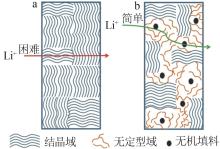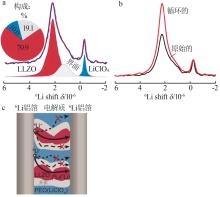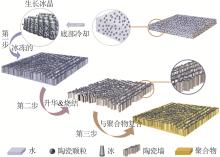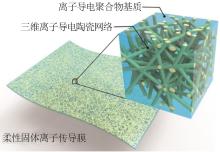Inorganic Chemicals Industry ›› 2025, Vol. 57 ›› Issue (3): 1-8.doi: 10.19964/j.issn.1006-4990.2024-0249
• Reviews and Special Topics • Next Articles
Research progress of PEO based organic/inorganic composite solid electrolyte
MA Jingyuan( ), LI Yan(
), LI Yan( ), ZHOU Hanjie(
), ZHOU Hanjie( ), LI Jiangang
), LI Jiangang
- College of New Materials and Chemical Engineering,Beijing Institute of Petrochemical Technology,Beijing 102627,China
-
Received:2024-05-07Online:2025-03-10Published:2024-06-13 -
Contact:LI Yan, ZHOU Hanjie E-mail:maaajy@foxmail.com;yanli@bipt.edu.cn;1371654732@qq.com
CLC Number:
Cite this article
MA Jingyuan, LI Yan, ZHOU Hanjie, LI Jiangang. Research progress of PEO based organic/inorganic composite solid electrolyte[J]. Inorganic Chemicals Industry, 2025, 57(3): 1-8.
share this article
Table 1
Properties of CSE added with inorganic fillers with different geometries"
| 固态电解质 | 离子电导率/ (S·cm-1) | 电化学性能 | |
|---|---|---|---|
| 0D | PEO/LiTFSI/8% 5 nmBaTiO3[ | 2.2×10-5(25 ℃) | 141 mA·h/g(LFP/Li, 0.1C,80 °C) |
| PEO/LiTFSI/10% LLZTO[ | 3.0×10-4(55 ℃) | 156 mA·h/g(LFP/Li, 0.1C,55 °C) | |
| PEO/LiClO4/52.5% LLZO[ | 4.4×10-4(55 ℃) | 166 mA·h/g(NCM622/Li,0.02C,55 °C) | |
| PEO/LiTFSI/1 μm LLZO[ | 4.0×10-3(70 ℃) | 168 mA·h/g(LFP/Li, 0.1C) | |
| PEO/LiTFSI/LAGP[ | 1.1×10-3(60 ℃) | 149 mA·h/g(LFP/Li, 0.3C,60 °C) | |
| 1D | PEO/LiTFSI/BaTiO3[ | 5.8×10-5(30 ℃) | 电化学窗口提升至5.8 V |
| PEO/LiTFSI/10% Mg2B2O5[ | 3.7×10-4(50 ℃) | 150 mA·h/g(LFP/Li, 0.2C,50 °C) | |
| PEO/LiTFSI/15% LLTO[ | 2.6×10-4(室温) | 电化学窗口提升至5 V | |
| PEO/LiTFSI/10% LLZTO[ | 2.1×10-4(25 ℃) | 电化学窗口提升至5 V,锂离子迁移数为0.57 | |
| 2D | PEO/LiTFSI/1% GO[ | 1.5×10-5(24 ℃) | 142 mA·h/g(LFP/Li, 0.5C,60 °C) |
| PEO/LiTFSI/1.5% Ti3C2T x[ | 1.3×10-5(室温) | 140 mA·h/g(LFP/Li, 0.3C,60 °C) | |
| 3D | PEO/LiTFSI/LLZAO[ | 2.5×10-4(室温) | 0.2 mA/cm2循环500 h |
| PEO/LiTFSI/LATP[ | 6.5×10-4(60 ℃) | 144 mA·h/g(LFP/Li, 0.2C,60 °C) | |
| PEO/LiTFSI/8% AF[ | 6.6×10-4(80 ℃) | 137 mA·h/g(LFP/Li, 0.2C,70 °C) | |
| 1 | CHEN Xilong, LI Xiangjie, LUO Lingjie,et al.Practical application of all-solid-state lithium batteries based on high-voltage cathodes:Challenges and progress[J].Advanced Energy Materials,2023,13(35):2301230. |
| 2 | 况新亮,刘垂祥,熊朋.锂离子电池产业分析及市场展望[J].无机盐工业,2022,54(8):12-19,32. |
| KUANG Xinliang, LIU Chuixiang, XIONG Peng.Industry analysis and market prospect of lithium ion battery[J].Inorganic Chemicals Industry,2022,54(8):12-19,32. | |
| 3 | HU Yilin, XIE Xiaoxin, LI Wei,et al.Recent progress of polymer electrolytes for solid-state lithium batteries[J].ACS Sustainable Chemistry & Engineering,2023,11(4):1253-1277. |
| 4 | 陈雪,欧阳全胜,邵姣婧.基于固-固反应机制锂硫电池的最新研究进展[J].无机盐工业,2024,56(9):12-23,97. |
| CHEN Xue, OUYANG Quansheng, SHAO Jiaojing.Recent research progress of lithium-sulfur batteries based on solid-solid reaction mechanism[J].Inorganic Chemicals Industry,2024,56(9):12-23,97. | |
| 5 | 康乐,景茂祥,李东红,等.铝酸锂纳米棒改性固态电解质的制备及电化学性能研究[J].无机盐工业,2023,55(8):65-70. |
| KANG Le, JING Maoxiang, LI Donghong,et al.Study on preparation and electrochemical performance of lithium aluminate nanorods modified solid electrolyte[J].Inorganic Chemicals Industry,2023,55(8):65-70. | |
| 6 | 黄飞,梁松苗,吴宗策,等.固态电解质的研究进展及其优化策略[J].矿冶,2024,33(2):154-166. |
| HUANG Fei, LIANG Songmiao, WU Zongce,et al.Research progress and optimization strategies of solid-state electrolytes[J].Mining and Metallurgy,2024,33(2):154-166. | |
| 7 | TANG Shuai, GUO Wei, FU Yongzhu.Advances in composite polymer electrolytes for lithium batteries and beyond[J].Advanced Energy Materials,2021,11(2):2000802. |
| 8 | NGUYEN A G, PARK C J.Insights into tailoring composite solid polymer electrolytes for solid-state lithium batteries[J].Journal of Membrane Science,2023,675:121552. |
| 9 | WU Yuqi, LI Xinhai, YAN Guochun,et al.Incorporating multifunctional LiAlSiO4 into polyethylene oxide for high-performance solid-state lithium batteries[J].Journal of Energy Chemistry,2021,53:116-123. |
| 10 | HUANG Xinwen, LIAO Songyi, LIU Rongtao,et al.Progress of PEO-modified polymer solid electrolytes for lithium ion batteri-es[J].Journal of Functional Materials,2020,51(9).Doi:10.3969/j.issn.1001-9731.2020.09.004 . |
| 11 | ZHANG Qingqing, LIU Kai, DING Fei,et al.Recent advances in solid polymer electrolytes for lithium batteries[J].Nano Research,2017,10(12):4139-4174. |
| 12 | ZHANG Yi, WANG Xiaohui, FENG Wei,et al.The effects of the size and content of BaTiO3 nanoparticles on solid polymer electrolytes for all-solid-state lithium-ion batteries[J].Journal of Solid State Electrochemistry,2019,23(3):749-758. |
| 13 | ZHUANG Hua, MA Wencheng, XIE Jingwei,et al.Solvent-free synthesis of PEO/garnet composite electrolyte for high-safety all-solid-state lithium batteries[J].Journal of Alloys and Compounds,2021,860:157915. |
| 14 | CHOI J H, LEE C H, YU J H,et al.Enhancement of ionic conductivity of composite membranes for all-solid-state lithium rechargeable batteries incorporating tetragonal Li7La3Zr2O12 into a polyethylene oxide matrix[J].Journal of Power Sources,2015,274:458-463. |
| 15 | ZAGÓRSKI J, SILVÁN B, SAUREL D,et al.Importance of composite electrolyte processing to improve the kinetics and energy density of Li metal solid-state batteries[J].ACS Applied Energy Materials,2020,3(9):8344-8355. |
| 16 | WANG Xue, ZHAI Haowei, Boyu QIE,et al.Rechargeable solid-state lithium metal batteries with vertically aligned ceramic nano-particle/polymer composite electrolyte[J].Nano Energy,2019,60:205-212. |
| 17 | ZHANG Zhoujie, WANG Qi, LI Zhihui,et al.Well-aligned BaTiO3 nanofibers via solution blow spinning and their application in lithium composite solid-state electrolyte[J].Materials Express,2019,9(9):993-1000. |
| 18 | SHENG Ouwei, JIN Chengbin, LUO Jianmin,et al.Mg2B2O5 nanowire enabled multifunctional solid-state electrolytes with high ionic conductivity,excellent mechanical properties,and flame-retardant performance[J].Nano Letters,2018,18(5):3104-3112. |
| 19 | ZHU Pei, YAN Chaoyi, DIRICAN M,et al.Li0.33La0.557TiO3 ceramic nanofiber-enhanced polyethylene oxide-based composite polymer electrolytes for all-solid-state lithium batteries[J].Journal of Materials Chemistry A,2018,6(10):4279-4285. |
| 20 | FAN Rong, LIU Chen, HE Kangqiang,et al.Versatile strategy for realizing flexible room-temperature all-solid-state battery through a synergistic combination of salt affluent PEO and Li6.75La 3 Zr1.75Ta0.25O12 nanofibers[J].ACS Applied Materials & Interfaces,2020,12(6):7222-7231. |
| 21 | WEN Jie, ZHAO Qiannan, JIANG Xiaoping,et al.Graphene oxide enabled flexible PEO-based solid polymer electrolyte for all-solid-state lithium metal battery[J].ACS Applied Energy Materials,2021,4(4):3660-3669. |
| 22 | PAN Qiwei, ZHENG Yongwei, KOTA S,et al.2D MXene-containing polymer electrolytes for all-solid-state lithium metal batteri-es[J].Nanoscale Advances,2019,1(1):395-402. |
| 23 | FU K K, GONG Yunhui, DAI Jiaqi,et al.Flexible,solid-state,ion-conducting membrane with 3D garnet nanofiber networks for lithium batteries[J].Proceedings of the National Academy of Sciences of the United States of America,2016,113(26):7094-7099. |
| 24 | LI Dan, CHEN Long, WANG Tianshi,et al.3D fiber-network-reinforced bicontinuous composite solid electrolyte for dendrite-free lithium metal batteries[J].ACS Applied Materials & Interfaces,2018,10(8):7069-7078. |
| 25 | ZENG Fanyou, SUN Yuanyuan, HUI Bin,et al.Three-dimensional porous alginate fiber membrane reinforced PEO-based solid polymer electrolyte for safe and high-performance lithium ion batteries[J].ACS Applied Materials & Interfaces,2020,12(39):43805-43812. |
| 26 | LI Jie, JING Maoxiang, LI Rui,et al.Al2O3 fiber-reinforced polymer solid electrolyte films with excellent lithium-ion transport properties for high-voltage solid-state lithium batteries[J].ACS Applied Polymer Materials,2022,4(10):7144-7151. |
| 27 | LUO Bi, WANG Weigang, WANG Qi,et al.Facilitating ionic conductivity and interfacial stability via oxygen vacancies-enriched TiO2 microrods for composite polymer electrolytes[J].Chemical Engineering Journal,2023,460:141329. |
| 28 | WANG Cheng, YANG Tianqi, ZHANG Wenkui,et al.Hydrogen bonding enhanced SiO2/PEO composite electrolytes for solid-state lithium batteries[J].Journal of Materials Chemistry A,2022,10(7):3400-3408. |
| 29 | YU Wen, DENG Nanping, YAN Zirui,et al.Mg-based inorganic nanofibers constructing fast and multi-dimensional ion conductive pathways for all-solid-state lithium metal batteries[J].Journal of Energy Chemistry,2022,67:684-696. |
| 30 | ZHENG Yun, YAO Yuze, Jiahua OU,et al.A review of composite solid-state electrolytes for lithium batteries:Fundamentals,key materials and advanced structures[J].Chemical Society Reviews,2020,49(23):8790-8839. |
| 31 | CROCE F, APPETECCHI G B, PERSI L,et al.Nanocomposite polymer electrolytes for lithium batteries[J].Nature,1998,394:456-458. |
| 32 | FAN Lizhen, Cewen NAN, ZHAO Shujin.Effect of modified SiO2 on the properties of PEO-based polymer electrolytes[J].Solid State Ionics,2003,164(1/2):81-86. |
| 33 | MO Hongsheng, YIN Yichen, LUO Jinda,et al.Lead-free solid-state organic-inorganic halide perovskite electrolyte for lithium-ion conduction[J].ACS Applied Materials & Interfaces,2022,14(15):17479-17485. |
| 34 | LI Yang, WANG Hui.Composite solid electrolytes with NASICON-type LATP and PVdF-HFP for solid-state lithium batteries[J].Industrial & Engineering Chemistry Research,2021,60(3):1494-1500. |
| 35 | TIAN Guiying, LI Huan, KHALID B,et al.Optimization for polyethylene glycol/garnet oxide composite electrolyte membrane for solid-state batteries[J].Chemical Engineering Journal,2022,430:132803. |
| 36 | ZHAO Ning, KHOKHAR W, BI Zhijie,et al.Solid garnet batteries[J].Joule,2019,3(5):1190-1199. |
| 37 | ZHENG Jin, TANG Mingxue, HU Yanyan.Lithium ion pathway within Li7La3Zr2O12-polyethylene oxide composite electrolytes[J].Angewandte Chemie,2016,128(40):12726-12730. |
| 38 | WANG Weimin, YI E, FICI A J,et al.Lithium ion conducting poly(ethylene oxide)-based solid electrolytes containing active or passive ceramic nanoparticles[J].The Journal of Physical Chemistry C,2017,121(5):2563-2573. |
| 39 | BAN Xiaoyao, ZHANG Wenqiang, CHEN Ning,et al.A High-performance and durable Poly(ethylene oxide)-based composite solid electrolyte for all solid-state lithium battery[J].The Journal of Physical Chemistry C,2018,122(18):9852-9858. |
| 40 | ZHANG Danyang, LI Lina, WU Xiaochao,et al.Research progress and application of PEO-based solid state polymer composite electrolytes[J].Frontiers in Energy Research,2021,9:726738. |
| 41 | ZHANG Yibo, CHEN Rujun, WANG Shuo,et al.Free-standing sulfide/polymer composite solid electrolyte membranes with high conductance for all-solid-state lithium batteries[J].Energy Storage Materials,2020,25:145-153. |
| 42 | ZHENG Jin, WANG Pengbo, LIU Haoyu,et al.Interface-enabled ion conduction in Li10GeP2S12-poly(ethylene oxide) hybrid electrolytes[J].ACS Applied Energy Materials,2019,2(2):1452-1459. |
| 43 | 张泓,徐浩然,韩春华,等.一维纳米储能材料的合成与应用[J].硅酸盐学报,2023,51(9):2228-2253. |
| ZHANG Hong, XU Haoran, HAN Chunhua,et al.Synthesis and application of one-dimensional nanomaterials for energy stor-age[J].Journal of the Chinese Ceramic Society,2023,51(9):2228-2253. | |
| 44 | LIU Wei, LEE S W, LIN Dingchang,et al.Enhancing ionic conductivity in composite polymer electrolytes with well-aligned ceramic nanowires[J].Nature Energy,2017,2(5):17035. |
| 45 | YU Jianming, WANG Chao, LI Shiheng,et al.Li+-containing,continuous silica nanofibers for high Li+ conductivity in composite polymer electrolyte[J].Small,2019,15(44):e1902729. |
| 46 | DAEMS K, YADAV P, DERMENCI K B,et al.Advances in inorganic,polymer and composite electrolytes:Mechanisms of lithium-ion transport and pathways to enhanced performance[J].Renewable and Sustainable Energy Reviews,2024,191:114136. |
| 47 | 国洪瑶,吴晓萌,吴勇民,等.无机填料在复合固态电解质中的作用机制研究进展[J].材料导报,2023,37(S1):1-8. |
| GUO Hongyao, WU Xiaomeng, WU Yongmin,et al.Research progress on the mechanism of action of inorganic fillers in composite solid electrolytes[J].Materials Reports,2023,37(S1):1-8. | |
| 48 | LA MONACA A, GIRARD G, SAVOIE S,et al.Synthesis of electrospun NASICON Li1.5Al0.5Ge1.5(PO4)3 solid electrolyte nanofibers by control of germanium hydrolysis[J].Journal of the Electrochemical Society,2021,168(11):110512. |
| 49 | 肖和,张文展,邱小林,等.MXenes及其复合材料在钾离子电池中的应用进展[J].化工新型材料,2022,50(5):6-9,15. |
| XIAO He, ZHANG Wenzhan, QIU Xiaolin,et al.Application of MXenes and its composite in potassium ion battery[J].New Che-Materials mical,2022,50(5):6-9,15. | |
| 50 | CHEN Qingqing, HU Jinlong, LU Jiqun,et al.Porous carbon nanosphere with multiple heteroatom doping derived from silicon oxycarbonitride as sulfur host for lithium-sulfur batteries[J].Energy Technology,2021,9(7):2100067. |
| 51 | 章炜,夏欢,曹昕,等.柔性锌离子电池水凝胶电解质研究进展[J].有机化学,2024,44(1):148-158. |
| ZHANG Wei, XIA Huan, CAO Xin,et al.Research progress on hydrogel electrolytes for flexible zinc-ion batteries[J].Chinese Journal of Organic Chemistry,2024,44(1):148-158. | |
| 52 | ZHOU Qing, SU Xiaonan, WU Jianqin,et al.Additive manufacturing of bioceramic implants for restoration bone engineering:Technologies,advances,and future perspectives[J].ACS Biomaterials Science & Engineering,2023,9(3):1164-1189. |
| 53 | FU Kun, GONG Yunhui, HITZ G T,et al.Three-dimensional bilayer garnet solid electrolyte based high energy density lithium metal-sulfur batteries[J].Energy & Environmental Science,2017,10(7):1568-1575. |
| 54 | PALMER M J, KALNAUS S, DIXIT M B,et al.A three-dimensional interconnected polymer/ceramic composite as a thin film solid electrolyte[J].Energy Storage Materials,2020,26:242-249. |
| [1] | JIANG Minghui, ZHANG Liqing, PANG Meijing, LIU Chao. Research progress of ion channels for achieving monovalent cation sieving [J]. Inorganic Chemicals Industry, 2025, 57(3): 9-17. |
| [2] | LI Chao, WANG Liping, GAO Guimei, ZHANG Yunfeng, HONG Yu, LIU Darui, XU Lijun, CUI Yongjie. Study on reaction mechanism of acid leaching lithium from circulating fluidized bed fly ash [J]. Inorganic Chemicals Industry, 2025, 57(3): 101-107. |
| [3] | SONG Jiaxi, JI Renfei, CHEN Jun, LIN Sen, YU Jianguo. Research on characteristics analysis and pretreatment on deeply deactivated power battery ternary cathode materials [J]. Inorganic Chemicals Industry, 2025, 57(2): 44-49. |
| [4] | KONG Lingjie, LI Guangbi, XIE Jiahao, YANG Xinhui, BAI Xiaoqin. Research progress on lithium extraction technology from salt lake brine [J]. Inorganic Chemicals Industry, 2025, 57(1): 14-26. |
| [5] | ZHANG Shanshan, ZENG Yule, ZHANG Ting, LIN Sen, LIU Chenglin. Research progress of cathode pre-lithiation technology for lithium-ion batteries [J]. Inorganic Chemicals Industry, 2025, 57(1): 1-13. |
| [6] | ZHAO Runze, QIAN A′niu. Research progress of lithium recovery for spent lithium-ion batteries and preparation in battery-grade lithium carbonate [J]. Inorganic Chemicals Industry, 2024, 56(12): 70-78. |
| [7] | FU Yu, ZHANG Boshuang, YANG Jianmao, LIU Jianyun. Research progress of lithium manganese oxide materials in electrochemical lithium extraction applications [J]. Inorganic Chemicals Industry, 2024, 56(12): 62-69. |
| [8] | WANG Ruirui, ZHU Chaoliang, MU Bing, MA Wanxia, FAN Jie, XU Guowang, SHI Yifei, DENG Xiaochuan, QING Binju. Preparation of cubic manganese carbonate by hydrothermal method and its application in extraction of lithium [J]. Inorganic Chemicals Industry, 2024, 56(12): 94-103. |
| [9] | GE Jianhua, XIE Minyan, OUYANG Quansheng, SHAO Jiaojing. Advances in regeneration processes of cathode materials for spent power batteries [J]. Inorganic Chemicals Industry, 2024, 56(12): 79-87. |
| [10] | CHENG Chunchun, LI Yulong, ZHANG Zhiqiang, ZUO Shuo, QIN Donglan, ZHOU Na, WANG Jiaqin. Study on agglomeration phenomenon and regulation method of lithium carbonate crystal prepared from potassium carbonate [J]. Inorganic Chemicals Industry, 2024, 56(10): 47-54. |
| [11] | MA Shuqing, LI Changwen, SHI Chenglong, QIN Yaru. Kinetic study of lithium extraction from solution with iron-based ionic liquid system [J]. Inorganic Chemicals Industry, 2024, 56(9): 60-66. |
| [12] | TIAN Peng, ZHANG Haoran, XU Jingang, MOU Chenxi, XU Qianjin, NING Guiling. Study on aluminum sol modified anode and cathode materials for lithium ion batteries [J]. Inorganic Chemicals Industry, 2024, 56(9): 44-53. |
| [13] | ZHU Zongjiang, WANG Gang, WEI Yuanfeng, TANG Yanhong, KAKUTA Cheng, LIU Chengbin. Research progress and prospect of resourceful recycling technology of electrolyte from decommissioned lithium⁃ion battery [J]. Inorganic Chemicals Industry, 2024, 56(7): 11-17. |
| [14] | SU Baocai, ZHANG Qin, XIE Yuanjian, CAI Pingxiong, PAN Yuanfeng. Advances in synthesis methods and structural modification of LiMnFePO4 materials [J]. Inorganic Chemicals Industry, 2024, 56(7): 28-36. |
| [15] | ZHU Zenghu, WANG Min, PENG Zhengjun, JIA Guofeng, LI Yan. Study on adsorption of potassium ions in lithium chloride solution [J]. Inorganic Chemicals Industry, 2024, 56(6): 61-66. |
| Viewed | ||||||
|
Full text |
|
|||||
|
Abstract |
|
|||||
|
||







